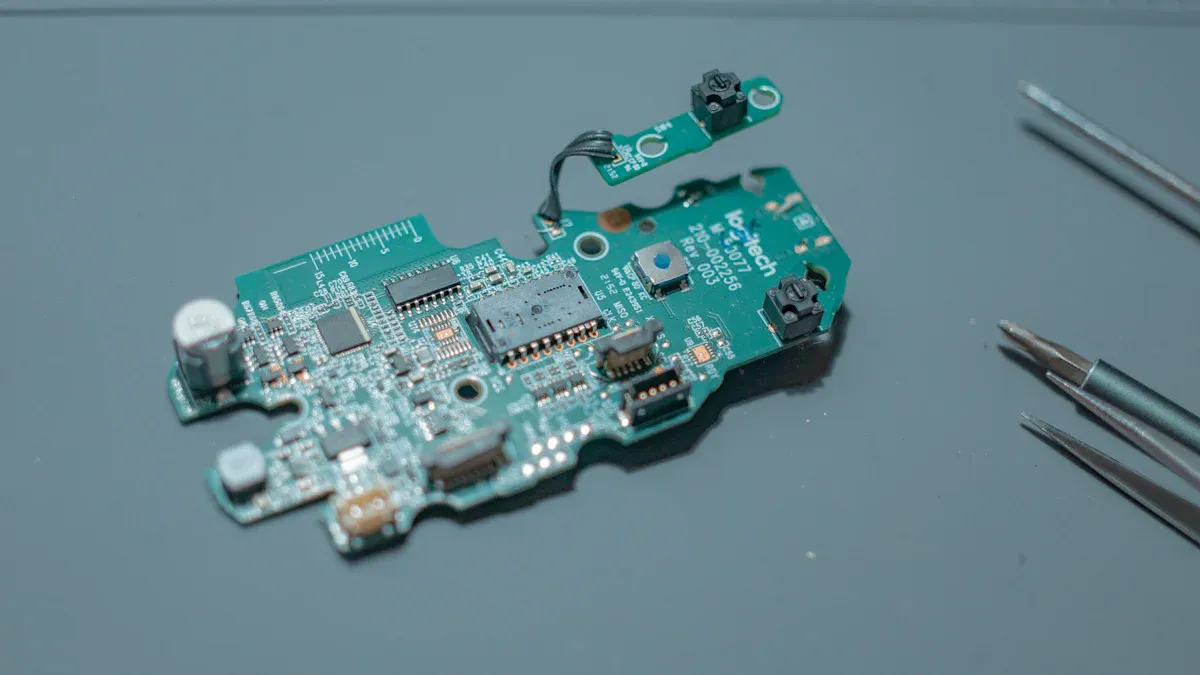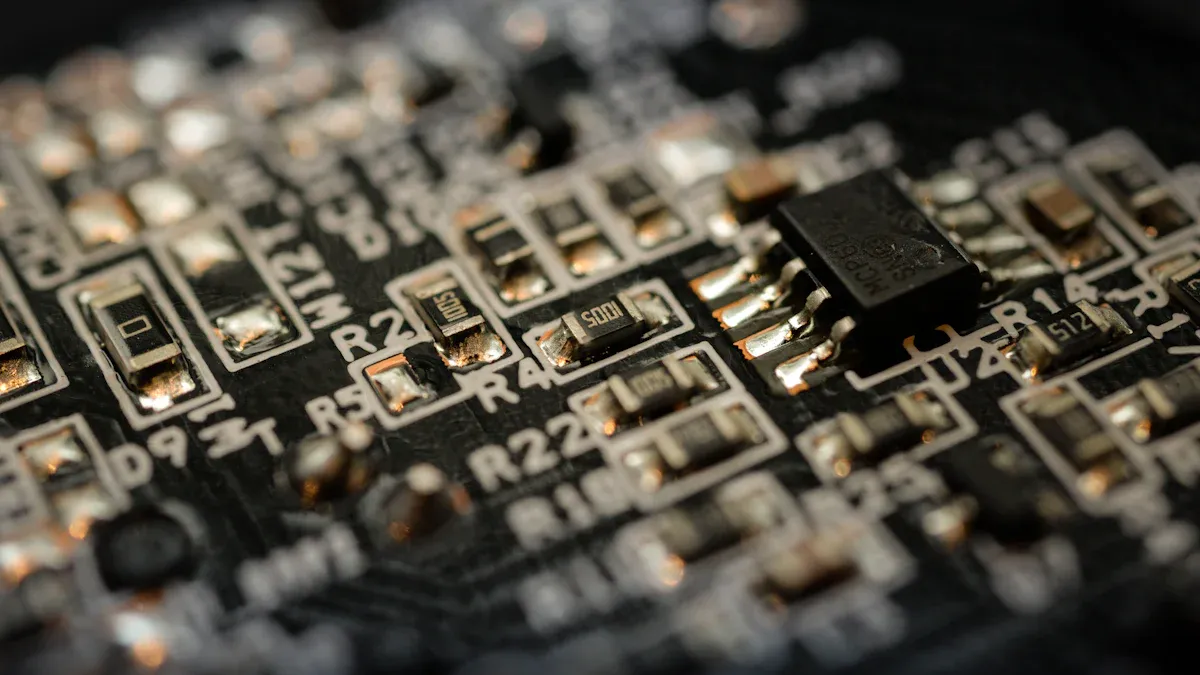![]()
Silicon carbide substrates are reshaping how you think about power electronics and LED technology. Their exceptional thermal conductivity, ranging from 3 to 4.9 W/m-K, outperforms traditional silicon, which only offers 1.5 to 1.7 W/m-K. This threefold advantage allows devices to handle higher power densities while staying cooler. In 2021, over 75% of the power semiconductor market embraced these SiC substrates for their wide band gap, making them ideal for high-performance applications. With a projected market size of $8.2 billion by 2033, silicon carbide technology is driving innovation across industries. Leading SiC substrate manufacturers, such as Ningbo VET Energy Technology Co., Ltd, are at the forefront of this transformation, providing high-quality SiC silicon carbide solutions to meet the growing demand.
Key Takeaways
- Silicon carbide spreads heat better, keeping devices cooler than silicon.
- It helps make smaller designs for electric cars and green energy.
- This material lasts long in tough conditions, making it dependable.
Why Silicon Carbide Substrates Outperform Traditional Silicon

Superior Thermal Conductivity and Heat Resistance
Silicon carbide substrates excel in thermal conductivity and heat resistance, making them indispensable for high-performance applications. With a thermal conductivity ranging from 120 to 270 W/m·K, they outperform traditional materials in dissipating heat efficiently. This property ensures that devices remain cooler even under intense workloads. Additionally, silicon carbide’s thermal stability up to 1,600°C (2,912°F) and its high sublimation temperature of approximately 2,700°C make it ideal for environments requiring extreme heat resistance, such as aerospace and energy production.
| Property | Description | Applications |
|---|---|---|
| Thermal Stability | Stable up to 1,600°C (2,912°F) | Aerospace, Energy production |
| Thermal Conductivity | Ranges from 120 to 270 W/m·K, higher than conventional materials | High power electronics cooling |
| Heat Resistance | High sublimation temperature (~2,700 °C), does not melt | Bearings, furnace parts |
These properties allow silicon carbide substrates to handle high-power applications with unmatched efficiency.
Higher Power Density and Switching Efficiency
Silicon carbide substrates enable higher power density and switching efficiency, revolutionizing power electronics. They can carry current densities up to five times higher than silicon, allowing for compact and powerful device designs. Their ability to operate at switching frequencies up to 10 times faster than silicon reduces the size of passive components, such as inductors and capacitors, leading to more compact systems. Furthermore, silicon carbide’s higher allowable junction temperature of 175°C and above enhances thermal management, ensuring reliable performance in demanding conditions.
| Benefit | Description |
|---|---|
| Improved Thermal Management | SiC has a much higher allowable junction temperature of 175°C and above, enhancing thermal performance. |
| Higher Current Carrying Capability | SiC devices can carry current densities up to five times higher than silicon, allowing for greater power density. |
| Higher Switching Frequencies | Capable of switching frequencies up to 10 times faster than silicon, reducing the size of passive components. |
| High Withstand Voltage | Enables design of high-power traction inverters with reduced losses, enhancing overall efficiency. |
These advantages make silicon carbide substrates a preferred choice for industries like automotive and renewable energy.
Enhanced Durability and Longevity in High-Stress Environments
Silicon carbide substrates offer exceptional durability, making them suitable for high-stress environments. Ranking second only to diamond on the Mohs scale, they exhibit remarkable hardness, providing excellent abrasion and scratch resistance. Their tensile and compressive strength ensures they withstand extreme mechanical stresses without deformation. Additionally, their chemical stability protects them from attacks by acids and alkalis, unlike traditional silicon.
- SiC’s hardness ensures superior abrasion and scratch resistance.
- Its thermal stability and mechanical strength make it more durable in extreme conditions.
- SiC resists chemical attacks, ensuring longevity in harsh environments.
These qualities make silicon carbide substrates a reliable solution for demanding applications, from industrial power supplies to aerospace components.
Applications of Silicon Carbide Substrates in Power Electronics

Electric Vehicles and Fast Charging Systems
Silicon carbide substrates are revolutionizing electric vehicles (EVs) and fast charging systems. Their superior properties enhance power conversion efficiency, reducing energy losses and improving overall vehicle performance. You benefit from higher power density, which allows for smaller and lighter EV components. This miniaturization not only saves space but also reduces the weight of power systems, contributing to better energy utilization and extended driving range.
The excellent thermal conductivity of silicon carbide substrates ensures reliable operation by minimizing heat buildup in power electronics. Fast switching speeds enable quicker charging of EV batteries, addressing one of the most common concerns—charging duration. By handling higher voltages, silicon carbide devices make rapid charging a reality, offering greater convenience for EV users.
Renewable Energy and Grid Infrastructure
Silicon carbide substrates play a critical role in renewable energy systems and grid infrastructure. In wind turbines, they improve energy conversion and control, ensuring efficient power generation. Solar power inverters benefit from their high breakdown voltage and switching frequency, enabling seamless energy transfer.
These substrates also enhance the efficiency of microgrids, which are essential for modern energy distribution. For instance, silicon carbide inverters operate at approximately 99% efficiency, compared to 98% for traditional silicon inverters. This seemingly small improvement translates to significant energy savings. In the U.S. alone, this efficiency boost could add 600 megawatts of solar power annually, showcasing the transformative impact of silicon carbide technology.
Industrial Power Supplies and Compact Designs
Industrial power supplies demand compact and efficient designs, and silicon carbide substrates deliver on both fronts. They enable the miniaturization of power systems, resulting in smaller, denser assemblies. This compactness improves thermal management by reducing heat generation, ensuring reliable operation in demanding environments.
Silicon carbide power devices also integrate components like motor drives and inverters into compact solutions. This integration reduces size and weight while lowering cooling requirements and material usage, leading to cost savings. Whether in electric vehicles, renewable energy systems, or industrial applications, silicon carbide substrates provide unmatched efficiency and reliability.
The Role of Silicon Carbide Substrates in the LED Industry
Improved Light Output and Energy Efficiency
Silicon carbide substrates significantly enhance the performance of LEDs by improving light output and energy efficiency. Their unique properties, such as a lattice mismatch of only 3.4% with gallium nitride (GaN), ensure better alignment during the manufacturing process. This low mismatch rate reduces defects, leading to brighter and more efficient LEDs. Additionally, the high thermal conductivity of silicon carbide, which is three times greater than silicon, ensures effective heat dissipation. This prevents overheating and maintains optimal performance.
| Evidence Type | Details |
|---|---|
| Lattice Mismatch | Silicon carbide has a lattice mismatch of only 3.4% with gallium nitride, compared to 13.9% for sapphire and 16.9% for silicon. |
| Thermal Conductivity | Silicon carbide has a thermal conductivity three times higher than silicon, enhancing heat dissipation in LEDs. |
| Electrical Conductivity | Silicon carbide allows for vertical LED structures, improving current distribution and reducing overheating. |
These advantages make silicon carbide substrates a preferred choice for high-performance LED applications.
Compact and Durable LED Designs
Silicon carbide substrates enable compact and durable LED designs. Their superior thermal conductivity and low lattice mismatch allow for smaller, more efficient LED structures. Compared to sapphire and monocrystalline silicon, silicon carbide offers better thermal and electrical conductivity, ensuring durability and reliability in demanding environments.
| Characteristic | Silicon Carbide | Sapphire | Monocrystalline Silicon |
|---|---|---|---|
| Thermal Conductivity (W•cm-1•k-1) | 3.0 | 0.3 | 1.3 |
| Lattice Mismatch (%) | 3.4 | 13.9 | 16.9 |
| Electrical Conductivity | Good | Poor (insulator) | Good |
These properties allow you to design LEDs that are not only compact but also robust enough to withstand harsh conditions.
Reduced Heat Generation for Longer Lifespan
Silicon carbide substrates reduce heat generation in LEDs, extending their lifespan. Their high thermal conductivity, combined with a low thermal mismatch rate of 15.92% with GaN, ensures efficient heat dissipation. This minimizes thermal stress, which is a common cause of LED failure. In contrast, sapphire substrates struggle with heat dissipation, making silicon carbide the superior choice for high-power LED applications. By using silicon carbide substrates, you can achieve LEDs that last longer and perform more reliably.
Ningbo VET Energy Technology Co., Ltd specializes in producing high-quality silicon carbide substrates, ensuring your LEDs benefit from these transformative properties.
Manufacturing Excellence of Silicon Carbide Substrates
Overview of the SiC Production Process
The production of silicon carbide substrates involves a series of precise and high-temperature processes. It begins with the Acheson process, where carbon and silica react in an electrical resistance furnace at temperatures ranging from 1,700°C to 2,500°C. This reaction forms solid silicon carbide crystals around a graphite core. Afterward, the material undergoes sorting, crushing, and processing to meet specific application needs.
In advanced manufacturing, chemical vapor deposition (CVD) plays a crucial role. This method uses precursor gases that thermally decompose to deposit high-purity silicon carbide layers. Post-processing steps, such as shaping and sintering, enhance the material’s properties. Rigorous quality control ensures that the final product meets the high standards required for power electronics and LED applications.
Ensuring Quality and Reliability in Manufacturing
You rely on silicon carbide substrates for their exceptional performance, so maintaining quality during production is essential. Manufacturers implement strict quality control measures to ensure purity and consistency. Advanced inspection techniques detect and eliminate defects, guaranteeing reliable performance in demanding environments. By focusing on precision and consistency, companies like Ningbo VET Energy Technology Co., Ltd deliver high-quality substrates that meet your expectations.
Innovations in SiC Wafer Production Technology
Recent innovations have transformed silicon carbide wafer production, improving efficiency and reducing costs. For example, advancements in chemical-mechanical planarization (CMP) processes enhance wafer quality by reducing surface defects. Improved crystal growth techniques minimize stress in wafers, addressing challenges like bow and warp. These improvements make handling and processing easier.
Collaborations between industry leaders have also driven innovation. For instance, Resonac Corporation and Soitec developed SmartSiC wafers, which increase yields and lower energy consumption during manufacturing. These advancements ensure that silicon carbide substrates remain at the forefront of technological progress, meeting the growing demand for high-performance materials.
Challenges and Misconceptions About Silicon Carbide Substrates
Addressing Cost and Scalability Concerns
Silicon carbide substrates offer unmatched performance, but their production involves significant costs. You may notice that these costs stem from several factors:
- High manufacturing expenses compared to traditional silicon substrates.
- Limited availability of high-quality raw materials like high-purity carbon and silicon.
- Technical challenges in wafer thinning and epilayer growth processes.
- Complex production methods requiring advanced equipment and expertise.
Processing larger wafers, such as 200-mm silicon carbide wafers, demands specialized tools with high automation. These tools increase initial production costs. However, long-term investments in advanced manufacturing techniques are expected to lower costs and improve yields. Over time, these improvements will make silicon carbide substrates more accessible for widespread applications.
Overcoming Misconceptions About Complexity
Some believe that silicon carbide substrates are too complex to manufacture or integrate into devices. This misconception arises from the intricate processes involved in their production. However, advancements in technology have simplified many of these steps. For example, innovations in epitaxial growth and wafer thinning have significantly improved substrate quality while reducing defects. These improvements enhance device performance and make silicon carbide substrates easier to adopt across industries.
By focusing on continuous innovation, manufacturers like Ningbo VET Energy Technology Co., Ltd ensure that silicon carbide substrates meet the highest standards without unnecessary complexity.
Industry Efforts to Streamline SiC Adoption
The industry is actively working to streamline the adoption of silicon carbide substrates. Continuous improvements in manufacturing processes, such as crystal growth and epitaxial techniques, have reduced costs and improved yield rates. These advancements enable wider integration into applications like electric vehicles and renewable energy systems.
| Evidence Description | Impact on Adoption |
|---|---|
| Enhanced wafer manufacturing processes | Lower costs and higher yields |
| Improved crystal growth technologies | Better substrate quality and functionality |
Innovative techniques have also increased the quality of 6-inch silicon carbide wafers, reducing defects and boosting device performance. These efforts ensure that silicon carbide substrates remain a cost-effective and scalable solution for modern technology.
The Future of Silicon Carbide Substrates in Power Electronics and LEDs
Expanding Applications Across Emerging Industries
Silicon carbide substrates are unlocking new possibilities across emerging industries. Their ability to handle high power and voltage makes them indispensable for advanced power electronics. You’ll find these substrates driving innovation in automotive, renewable energy, and industrial applications.
- The global silicon carbide substrate market is projected to grow from USD 2.7 billion in 2022 to USD 8.2 billion by 2033, reflecting a compound annual growth rate of 13.2%.
- SiC power modules are transforming energy, e-mobility, and industrial systems by enhancing power efficiency and reducing operational costs.
- Their superior thermal conductivity and electrical performance make them ideal for high-demand applications like electric vehicles and solar inverters.
This growth highlights the expanding role of silicon carbide substrates in shaping the future of technology.
Driving Sustainability and Energy Efficiency
Silicon carbide substrates contribute significantly to sustainability by improving energy efficiency. They enable more efficient energy conversion, reducing energy losses in critical systems.
- SiC devices operate at higher breakdown fields (2.8 x 10^6 V/cm) compared to silicon, allowing for greater efficiency.
- Their bandgap energy of 3.26 eV supports higher operating temperatures, enhancing reliability.
- With thermal conductivity three times higher than silicon, SiC ensures better thermal management.
For example, SiC inverters in solar energy systems achieve 99% efficiency, minimizing energy loss and supporting sustainable energy solutions.
Innovations Shaping the Next Generation of SiC Technology
Ongoing advancements in silicon carbide technology are expanding its applications and improving performance. Innovations like Soitec’s SmartSiC™ enhance electric vehicle efficiency with longer ranges and faster charging. Research focuses on improving durability and performance under extreme conditions, making SiC substrates more versatile.
- SiC wafers now feature a breakdown electric field strength ten times that of silicon.
- Their stable crystal lattice, formed by strong covalent bonds, ensures reliability in demanding environments.
- Advancements in wafer manufacturing, such as epitaxial growth and wafer thinning, reduce costs and improve quality.
These innovations ensure that silicon carbide substrates remain at the forefront of technological progress, meeting the growing demand for high-performance materials.
Silicon carbide substrates are revolutionizing power electronics and LED industries by delivering unmatched efficiency, durability, and compactness. Their superior properties, such as higher thermal conductivity and voltage tolerance, enable advancements in high-power applications. The market, projected to reach $8.2 billion by 2033, reflects their growing importance. As industries prioritize energy efficiency, these substrates will continue driving innovation and sustainability.
Key Takeaway:
Silicon carbide substrates outperform traditional silicon in efficiency, reliability, and thermal management, making them indispensable for next-generation technologies.
FAQ
What makes silicon carbide substrates better than traditional silicon?
Silicon carbide substrates offer higher thermal conductivity, better durability, and improved efficiency. These properties make them ideal for high-performance applications like electric vehicles and LEDs.
How do silicon carbide substrates improve LED performance?
Silicon carbide substrates enhance LED brightness and energy efficiency by reducing defects during manufacturing. Their superior thermal conductivity also ensures better heat dissipation for longer-lasting LEDs.
Where can you find high-quality silicon carbide substrates?
You can rely on Ningbo VET Energy Technology Co., Ltd for premium silicon carbide substrates. Their advanced manufacturing ensures exceptional quality for power electronics and LED applications.






